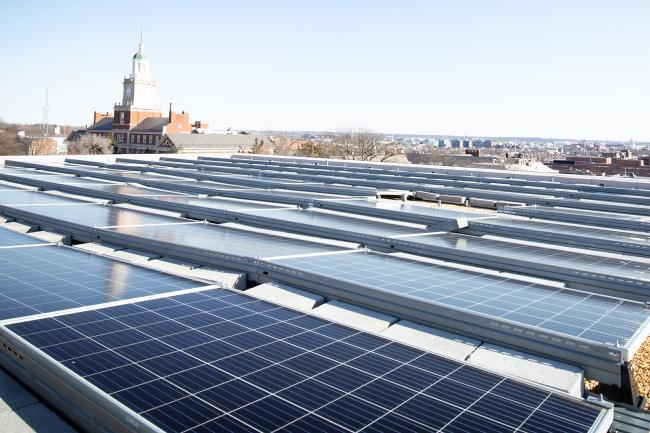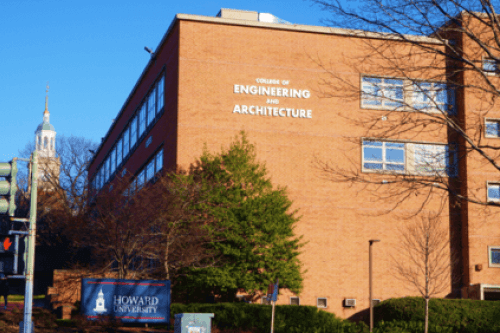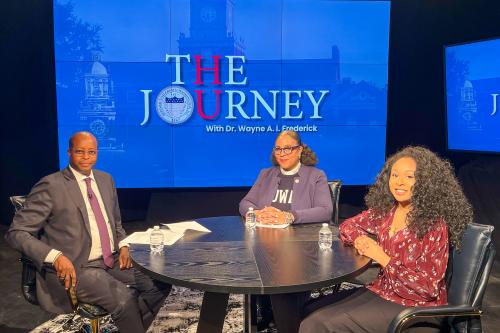As Howard University prepares to embark on its largest real estate initiative in institutional history by investing $785 million in new construction and renovation projects, sustainable initiatives will factor prominently in all aspects of this campus transformation.
“Sustainability is a major factor in everything that we do,” says Derrek Niec-Williams, Howard’s executive director of campus planning, architecture and development. In our current era, sustainability touches just about every aspect of building or renovating a facility on campus, as well as the design of spaces in between and around those buildings.
According to the “2020 Central Campus Master Plan,” among other sustainable considerations, Howard strives to use building materials with a reduced carbon footprint, capture and reuse water, ensure energy is used most efficiently and more.
Niec-Williams points to numerous on-campus projects that are “wins in the sustainability realm” that will be used as templates and models for future efforts. For instance, Howard has partnered with Volt Energy, a minority-owned business co-founded by Howard alumnus Gilbert Campbell (BBA ’01), to install solar panels around campus.
Sustainability is a major factor in everything that we do.”
At the West Campus, Howard has retrofitted a large surface parking lot to more effectively manage stormwater runoff. Prior to the renovation project, untreated stormwater would flow from the parking lot into nearby streams. These stormwater management improvements dramatically reduce harmful substances from flowing into the stream.
Howard has also installed new utility meters to better collect data and monitor energy usage in buildings across campus. The University has installed more energy-efficient LED lighting in numerous indoor and outdoor spaces. Additionally, Howard managed to attain an LEED Gold certification for the recent Interdisciplinary Research Building.
As Howard creates spaces that are designed, in part, to conduct research on issues like climate change and environmental justice, it is important that Howard’s own campus reflect the changes it advocates for in the world at large.
“Howard [is an academic leader] in environmental justice,” says Lisa Goldberg, assistant vice president of environment, health, safety and sustainability. “It’s important to walk the walk, if you will,” she says, noting how it’s not enough for Howard to conduct research and emphasize sustainability in its academic offerings; the University has to reflect those priorities by investing in sustainable initiatives on campus.
But of course, this sort of ideological consistency isn’t the only motivator or benefit of Howard’s sustainable initiatives.
“[Sustainability] generates green in [multiple] ways,” Goldberg says – environmentally, but also financially.
Niec-Williams says that it’s important to be “judicious with our energy footprint because it costs us money.” The more money the University saves in energy and facilities costs, the more it can reinvest in related initiatives that benefit the Howard community.
Of course, emphasizing sustainability presents challenges as well. “A lot of times, two [University priorities] can come into direct conflict with one another.”
While sustainable initiatives might save money in the long run, they often cost more up front. In addition, Howard often has to balance historic preservation with the need for sustainable upgrades. Some of Howard’s oldest and most significant buildings were not necessarily built with sustainable materials or designed with modern sustainable priorities in mind. The question becomes how the University can make sustainable changes without sacrificing the historic qualities of the building.
“By contemporary standards, Douglass Hall and the Undergraduate Library had very archaic HVAC systems,” Niec-Williams says. “The renovation delivered more energy efficient systems in both of those buildings.”
To be a leader [in sustainability] among HBCUs and minority-serving institutions – that’s always been a goal.”
According to Alfonzye “Chip” Chisholm, director of capital planning and sustainability, who has been working on sustainability initiatives at the University for more than two decades, it’s important for Howard to be a leader in this arena. “To be a leader among HBCUs and minority-serving institutions – that’s always been a goal,” Chisholm says. When he first began having meetings about sustainability with other institutions, he was usually the only minority in the room. “At the time, we were [one of the] only universit[ies] that had a sustainability office. … We were the early leaders, and people look to us as an example.”
While University recent administrations have demonstrated their commitment to sustainability, Chisholm acknowledges the significant role that students and the local government have played to accelerate the pace of change on campus.
“The University quickly started realizing that if they were going to attract the best and brightest students, [it] had to seriously consider sustainability,” Chisholm says. “I would say that’s probably the beginning of sustainability on campus was our recycling program,” he says, noting that student interest in the program helped bring it to fruition.
In addition, Howard must ensure that all of its facilities are in compliance with local requirements. Chisholm says D.C. was an early adopter of sustainability standards, and that external pressure helped motivate and kickstart many of the sustainable efforts on Howard’s campus.
Of course, the success of sustainability on Howard’s campus is determined by much more than the efforts of the administration. From collaborating with other institutions of higher education to receiving funding from external sources, sustainability at Howard is a matter of partnership. Howard has won different competitions to get funding for its initiatives, including the Home Depot Retool Your School HBCU grant competition and the Alliance to Save Energy’s D.C. Campus Challenge: How Much Can You Power Down? In the latter, Howard won the competition by reducing its campus energy usage more than the other competing schools.
Ultimately, the success of Howard’s sustainability efforts depends on the entire University community’s cooperation.
“We all need to work together to improve our sustainability overall,” Niec-Williams says. “But I think that we don’t want to lose sight of the human element. We’re doing this is to make people’s lives better – today, and for future generations, and that’s what Howard University is all about.”
The University is currently developing a Campus Sustainability Plan that is intended to be completed by Fall 2022. "Once created, this will serve to integrate all sustainability projects across campus within a unified plan," Goldberg says.





